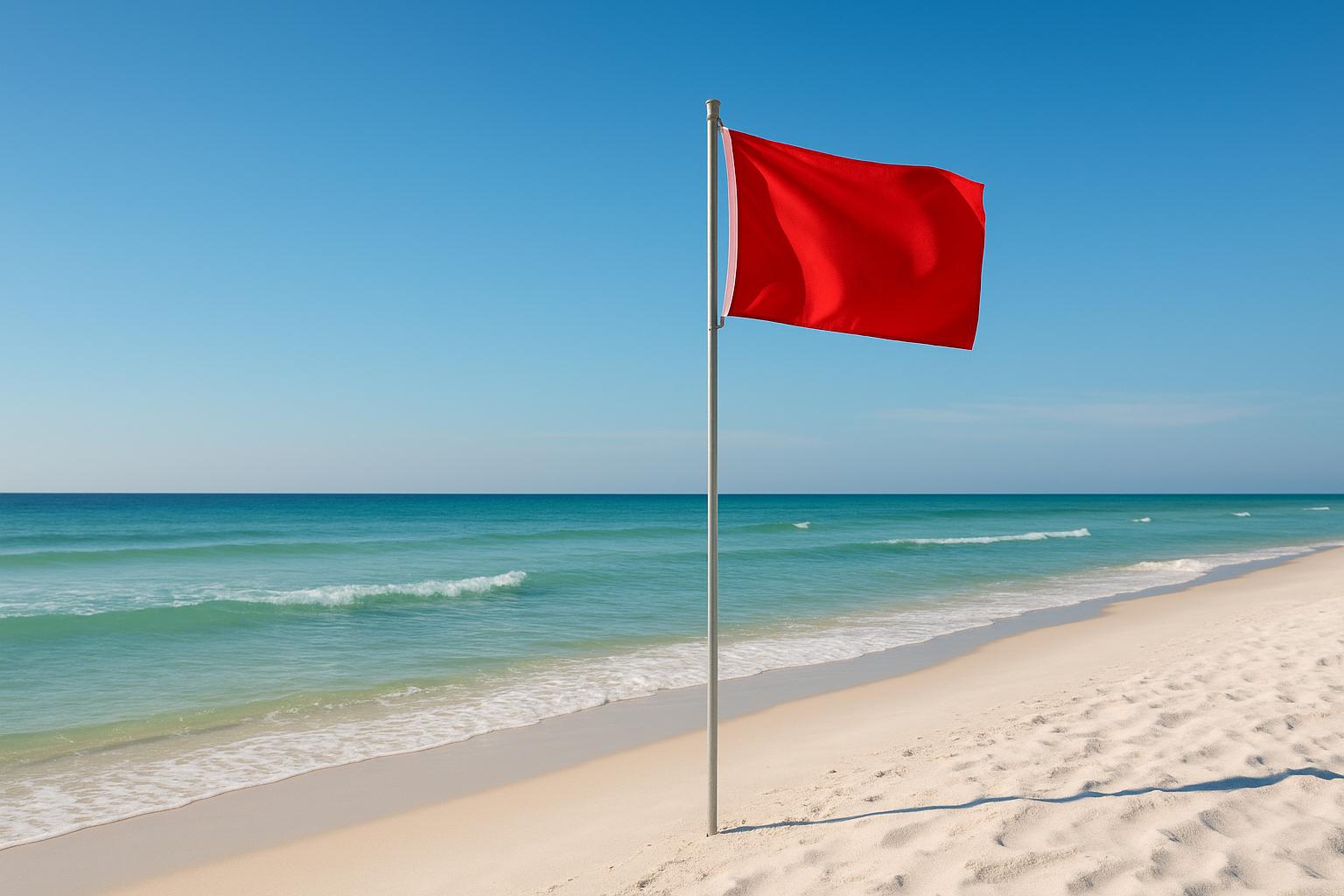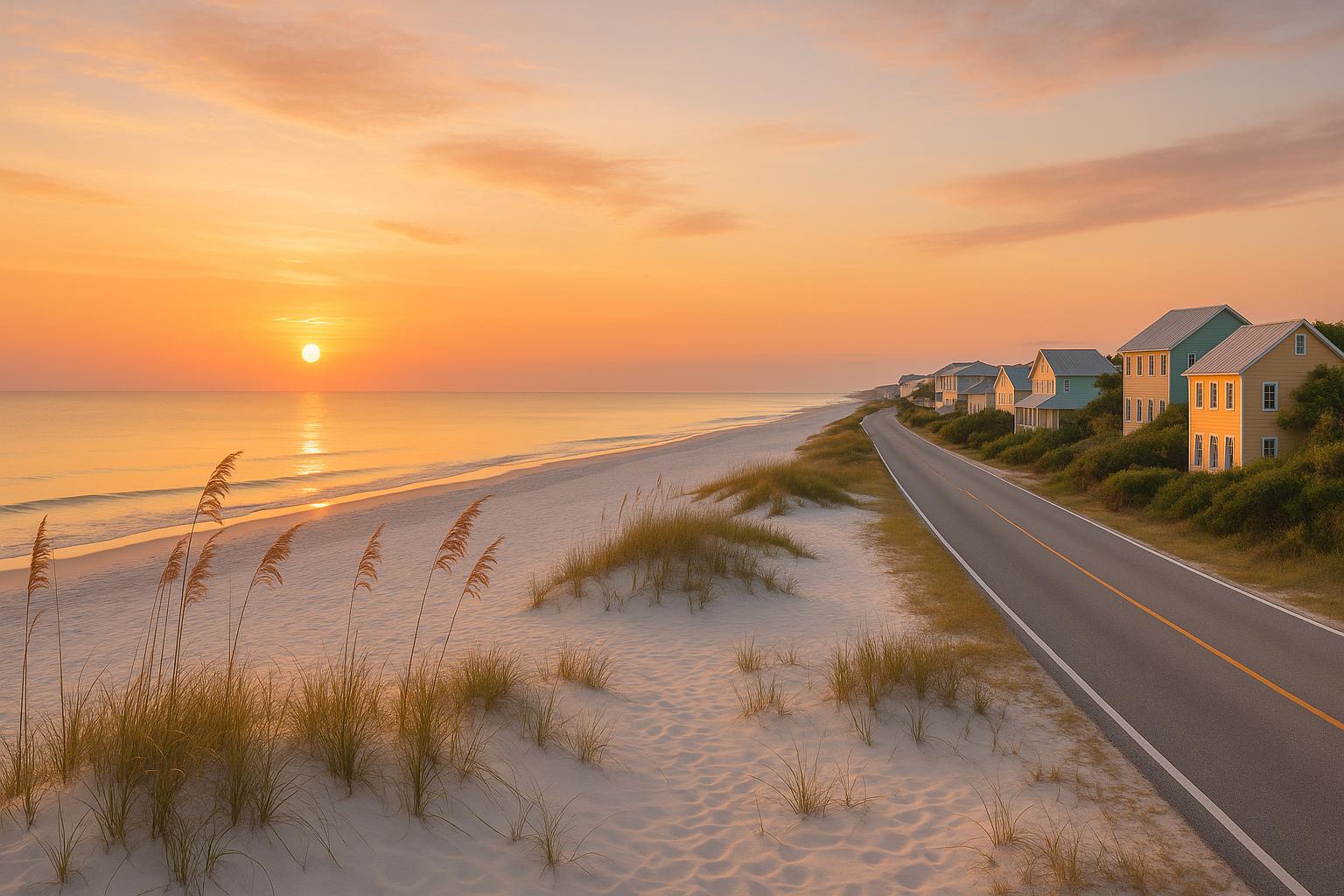Stretching along Florida's Gulf Coast, 30A is a paradise for birdwatchers. With over 200 bird species thriving in its diverse habitats, this area offers unique opportunities for spotting both resident and migratory birds. From coastal dune lakes to pine forests, 30A's landscapes are a magnet for nature enthusiasts. Whether you're a seasoned birder or a beginner, these seven locations provide a variety of settings to enjoy.
Highlights:
- Grayton Beach State Park: Rare coastal dune lakes, Snowy Plovers, and Bald Eagles.
- Topsail Hill Preserve State Park: Over 200 species, including Red-headed Woodpeckers and Ospreys.
- Eden Gardens State Park: Peaceful gardens with songbirds and woodpeckers.
- Deer Lake State Park: Great Horned Owls and Prothonotary Warblers in rare ecosystems.
- Camp Helen State Park: Waterbirds and migratory species near Lake Powell.
- Point Washington State Forest: Pine flatwoods with warblers, buntings, and raptors.
- Inlet Beach & Alys Beach Nature Trail: Shorebirds like Semipalmated Plovers and nocturnal owls.
Best Times to Visit:
- Fall and Spring: Peak migration seasons.
- Early Mornings and Late Afternoons: Birds are most active during these times.
Each spot offers unique habitats and bird species, making 30A a must-visit for birding enthusiasts. Entry fees range from $4–$6 for state parks, while some locations are free. Plan your visit during migration seasons for the best experience.
Hidden Treasure Topsail State Park, 30A Florida #TopsailHillPreserve #NoNameLake #floridanature
1. Grayton Beach State Park
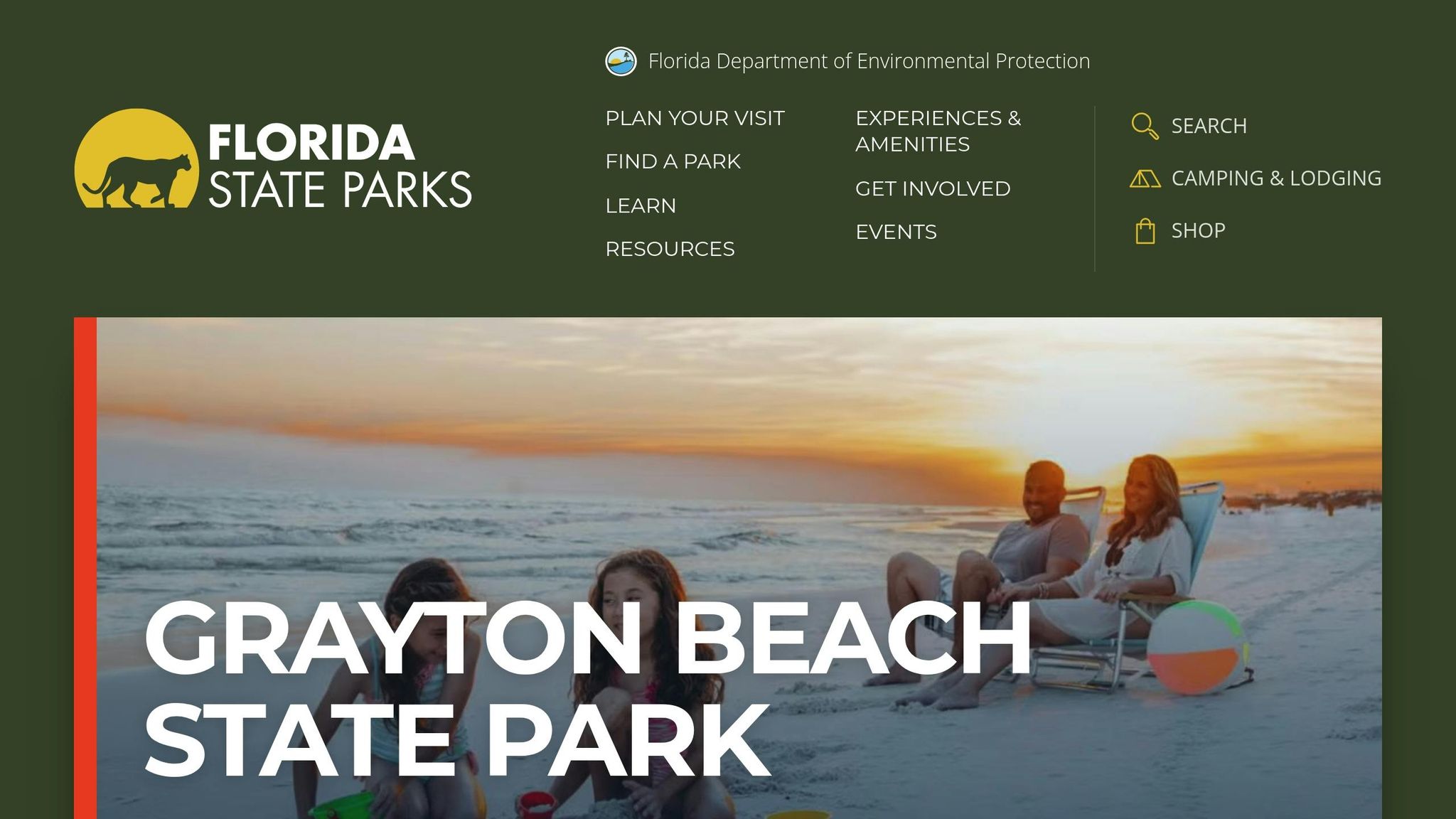
Grayton Beach State Park, covering 2,186 acres along the Gulf Coast, is a standout spot for birdwatching. Its mix of untouched beaches and varied habitats provides a haven for both resident and migratory birds throughout the year.
Habitat Diversity
What makes this park special is its range of habitats. Pine flatwoods serve as nesting grounds for species like Eastern Bluebirds and Brown-headed Nuthatches. Nearby, sandy dunes and sand live oak canopies add to the ecological variety. A highlight is Western Lake, a rare brackish coastal dune lake that draws wading birds and other species suited to wetland environments. Positioned along major migration routes, Grayton Beach is a vital rest stop for birds during their fall and spring journeys. This mix of ecosystems creates a rich environment for birdwatchers.
Bird Species Variety
The park is home to an impressive variety of bird species. Great Blue Herons are a common sight at Western Lake, while Bald Eagles and Barred Owls are often spotted overhead. The beach areas are crucial nesting grounds for Snowy Plovers, a species carefully monitored during breeding season. In winter, birdwatchers can look for Bonaparte's Gulls, Northern Gannets offshore, and Common Loons near Western Lake. Migration seasons are particularly exciting, with up to 15 species of wood-warblers - including Blackpoll and Hooded Warblers - passing through.
Accessibility
Grayton Beach State Park makes birdwatching easy for everyone. The ranger station provides loaner optics and field guides to help visitors get the most out of their experience. Trails like the 1-mile interpretive trail, the 4.2-mile hike and bike trail, and the Lake Loop Trail offer access to a range of habitats, enhancing your chances of spotting diverse bird species.
Best Visiting Times
Timing is everything when it comes to birdwatching here. Fall migration is particularly rewarding as birds follow cold fronts through the area, but spring migration is equally impressive. Winter also offers unique birding opportunities. The park is open daily from 8:00 AM until sunset, and early mornings or late afternoons are the best times to catch birds at their most active. For a quieter experience, plan your visit on a weekday.
2. Topsail Hill Preserve State Park
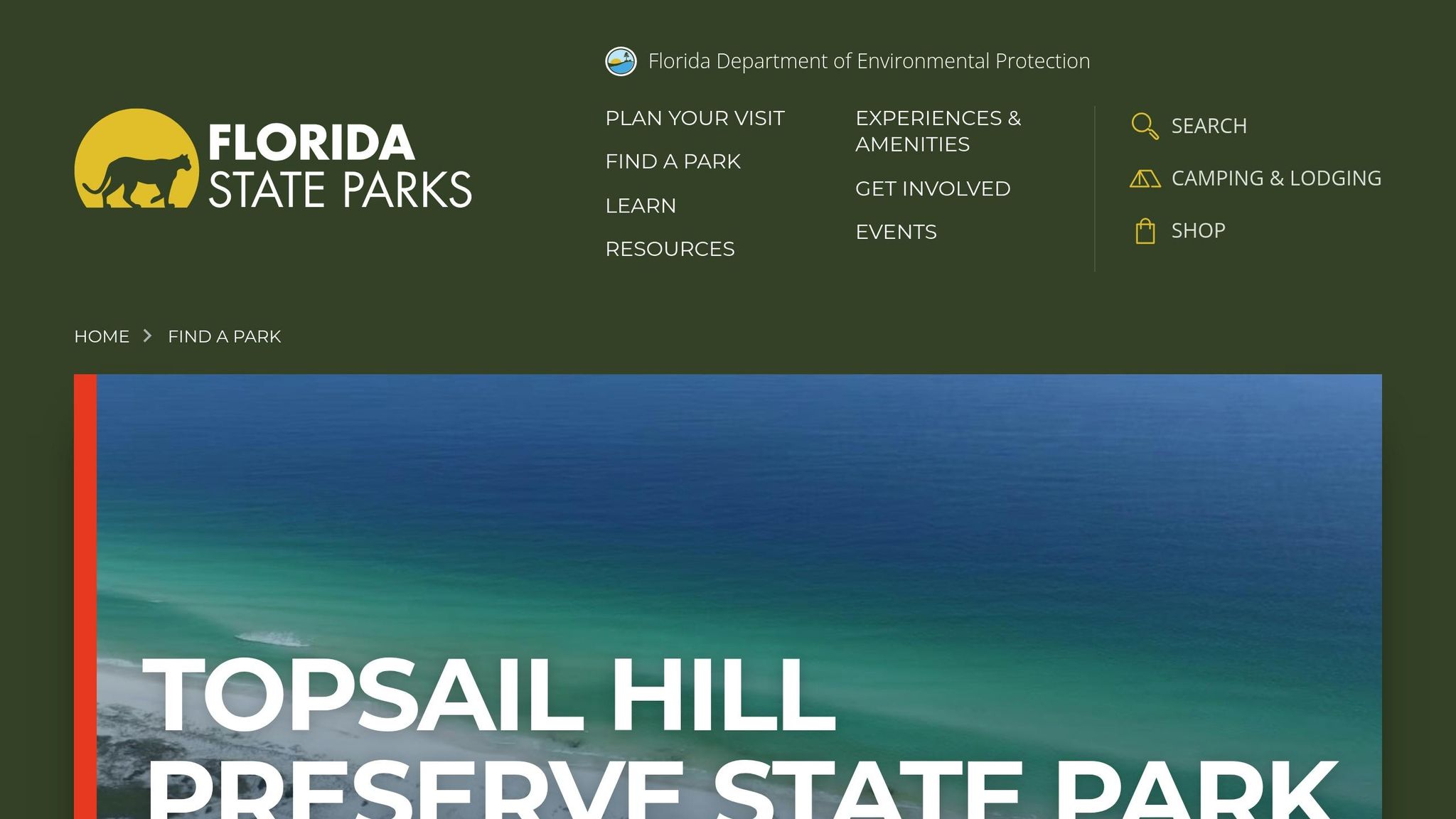
Spanning 1,640 acres, Topsail Hill Preserve State Park is a haven for bird lovers, boasting over 200 bird species throughout the year. Whether you're new to birdwatching or a seasoned pro, this spot along 30A is a standout destination. Its rare coastal ecosystems create a rich environment for birdlife, offering unique opportunities to observe a variety of species across different habitats.
Habitat Diversity
Topsail Hill's diverse landscapes provide a home for an impressive range of birds. The park's coastal dune lakes - an extremely rare phenomenon globally - draw wading birds and waterfowl. These freshwater lakes, paired with untouched beaches and towering dunes, are vital feeding and resting grounds for shorebirds. Further inland, the pine flatwoods resonate with the sounds of woodpeckers and songbirds, while wetlands and ponds support aquatic species. Situated along major migratory flyways, the park serves as a critical stopover for birds traveling between breeding and wintering grounds.
Bird Species Variety
The park is teeming with both resident and migratory birds. Red-headed Woodpeckers can often be heard drumming in the pines, while wetlands attract a variety of warblers. Ospreys and Bald Eagles soar overhead, with Florida hosting the third-largest breeding population of Bald Eagles in the U.S.. The coastal dune lakes are frequented by Great Egrets, herons, and shorebirds like Semipalmated Plovers. During migration seasons, the park comes alive with waves of warblers, flycatchers, and other songbirds taking a much-needed rest in its diverse habitats.
Accessibility
The park is designed to welcome birdwatchers of all abilities. Paved trails, boardwalks, and nearby parking make it easy to access prime birding spots. The visitor center is a great resource, offering maps, birding tips, and updates on recent sightings from knowledgeable staff. While some remote trails through the dunes and forests may pose challenges for those with mobility issues, the main areas are well-equipped for exploration.
Best Visiting Times
For the best birdwatching experience, plan your visit during the early morning or late afternoon when bird activity is at its peak. The park is open daily from 8:00 AM to sunset. Fall migration is the highlight of the year, as cold fronts bring a wide variety of species through the area. Spring is another excellent season, offering an impressive array of birds. Winter visitors can spot both resident and wintering species around the lakes and dunes. With a $6 per vehicle admission fee, Topsail Hill offers an affordable and rewarding experience year-round.
3. Eden Gardens State Park
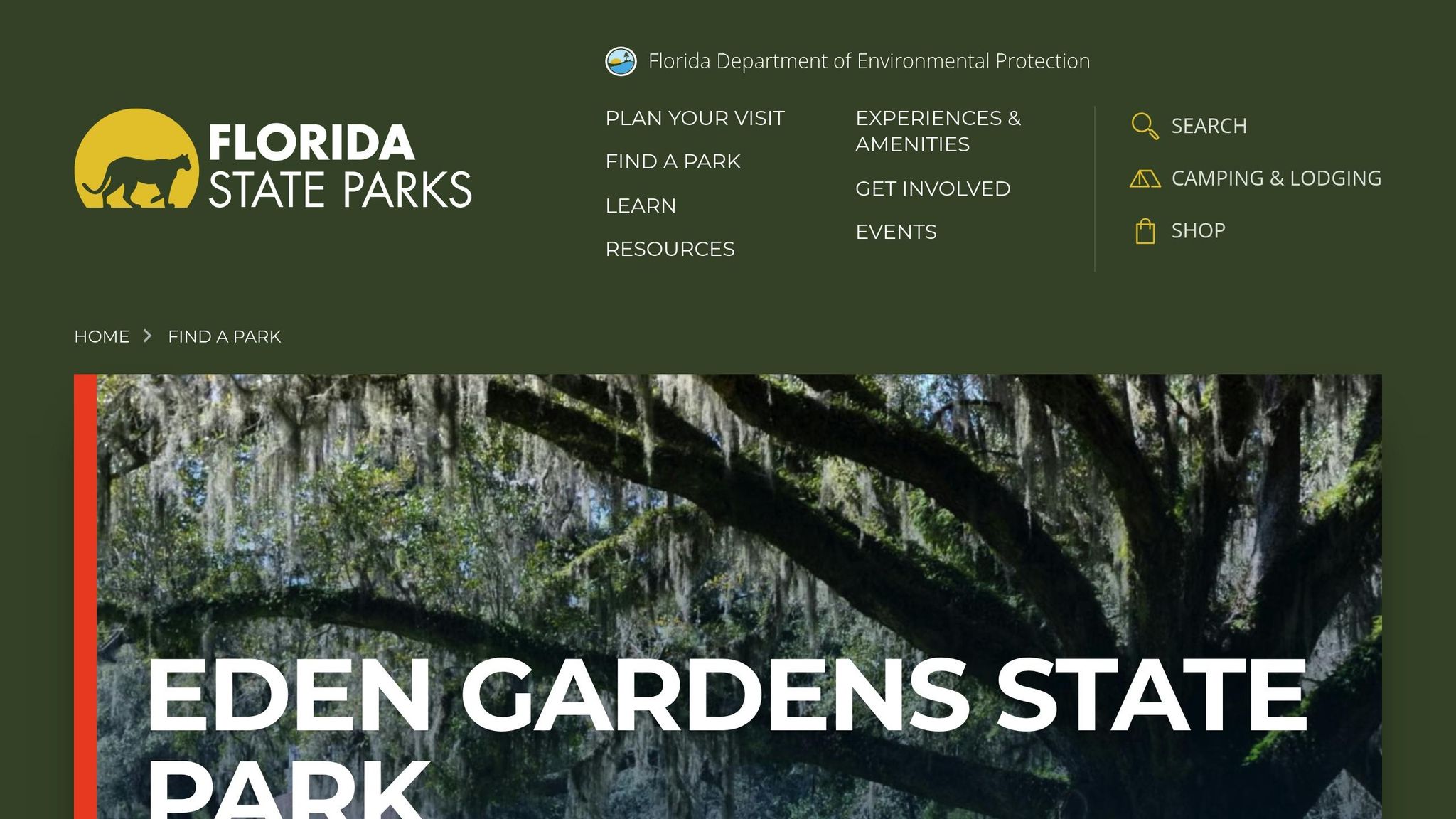
Nestled along the scenic 30A corridor, Eden Gardens State Park combines history and nature in a serene setting. The park's beautifully maintained grounds are a peaceful retreat, offering bird enthusiasts a chance to observe both local and migratory species. While specific bird species aren't extensively cataloged, the park's historic charm adds a unique layer to the birdwatching experience. For the latest visitor information, be sure to visit the park's official website.
4. Deer Lake State Park
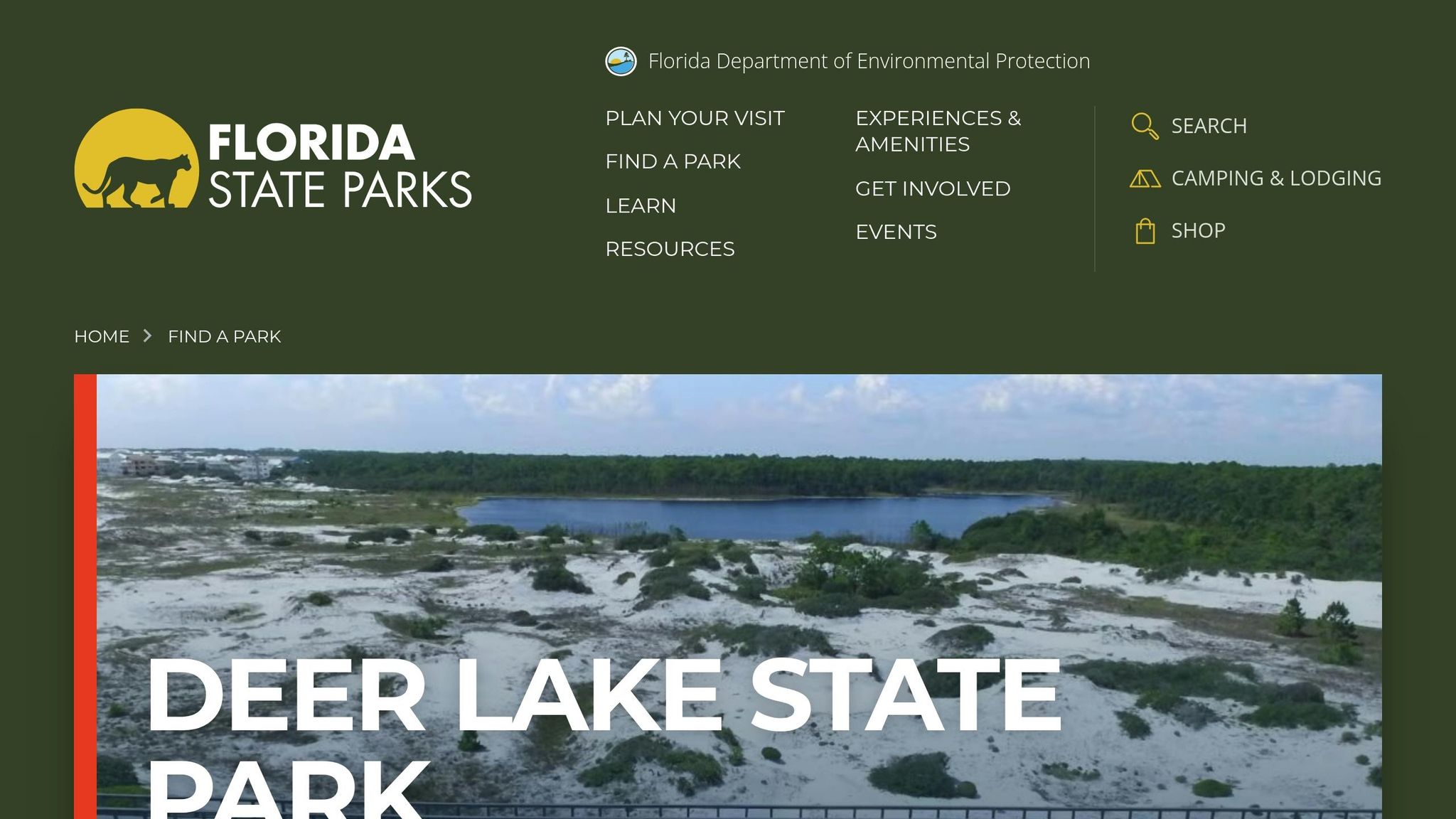
Deer Lake State Park is a standout birdwatching destination along 30A, offering visitors a chance to experience the rare beauty of a coastal dune lake ecosystem. Its compact yet diverse habitats make it appealing to both beginner and seasoned birdwatchers. The variety of landscapes here creates an exciting environment for spotting a wide range of bird species.
Habitat Diversity
What makes Deer Lake State Park special is its blend of habitats. Within a single visit, you can explore rare coastal dune lakes, freshwater marshes, pine flatwoods, coastal scrub, and the park's stunning white sand beaches - all in one place. This mix supports an incredible range of birdlife throughout the year.
The 1.5-mile nature trail takes you through dense pine forests and leads to breathtaking views of the Gulf and the unique coastal dune lake. This ecosystem is considered globally rare, making the park a treasure for birdwatchers and nature lovers alike.
Bird Species Variety
Deer Lake State Park is a hotspot for bird diversity in the region. Its combination of forested areas and water sources attracts both land and water birds, offering something for everyone.
Wading birds like herons and egrets are often seen in the marshes and along the shores of the dune lake. Raptors such as ospreys and bald eagles frequently soar overhead. The dense forests are home to woodpeckers, songbirds, and even the Great Horned Owl, which is commonly heard or seen during the evening hours.
During migration seasons, the park becomes a haven for rarer species, including the red-headed woodpecker and the prothonotary warbler. Its location along major migratory flyways increases the chances of spotting these less common birds, especially during peak migration periods.
Accessibility
Deer Lake State Park is designed with accessibility in mind, making it a great choice for birdwatchers of all levels. The main entrance provides convenient parking, with a day-use fee of $3–$6. Boardwalks and well-maintained trails allow easy access to the beach, dune lake, and forested areas, making the park enjoyable for visitors of all ages and abilities.
Restrooms are located near the parking area, and the park is known for being less crowded than other spots along 30A. This quieter atmosphere offers a more peaceful and immersive birdwatching experience compared to busier parks along the coast. The park is open daily from 8:00 AM to sunset, under the management of the Florida Department of Environmental Protection.
Best Visiting Times
For the best birdwatching, plan your visit during the fall and spring migration seasons, when bird activity and variety are at their highest. Early mornings and late afternoons are ideal, as birds are most active during these cooler times of the day.
If you're hoping to catch a glimpse of nocturnal species like the Great Horned Owl, twilight hours are your best bet. The park's thick forests provide the perfect backdrop for spotting these elusive birds. Whether you're an avid birder or just looking to enjoy nature, Deer Lake State Park offers unforgettable opportunities to connect with the avian world.
sbb-itb-d06eda6
5. Camp Helen State Park

Camp Helen State Park is a birdwatcher's paradise, boasting over 200 bird species throughout the year. Nestled at the western end of Panama City Beach and bordering Lake Powell - Florida's largest coastal dune lake - this park offers the unique opportunity to observe both water and land birds in a single visit. Its varied ecosystems make it a must-visit destination for nature enthusiasts.
Habitat Diversity
The park is home to an impressive mix of habitats, including coastal dune lakes, salt marshes, freshwater wetlands, sand dunes, and maritime forests. Each of these environments supports distinct bird communities, allowing visitors to experience a wide range of species within a relatively small area. From waterbirds in the marshes to woodland species in the forests, the diversity here is unmatched.
Lake Powell, with its vast freshwater expanse, provides a vital habitat for waterfowl and marsh birds, offering birding experiences that stand out in the 30A region. The surrounding salt marshes and wetlands serve as feeding and nesting grounds for wading birds, while the maritime forests provide shelter and nourishment for migratory songbirds and year-round residents.
Bird Species Variety
Camp Helen's location, situated between two major bird migration flyways, makes it a hotspot for both resident and migratory birds. Visitors can expect to see Brown Pelicans, Ospreys, herons, and egrets throughout the year. Ospreys, in particular, are a highlight as they dive for fish in the coastal dune lake. Along the sandy shores, shorebirds are a common sight, while raptors can often be seen soaring above.
During migration seasons, the park becomes even more dynamic. Migratory songbirds and raptors pass through in large numbers, with the maritime forests buzzing with activity, especially during spring migration. Flocks of warblers create memorable moments for birdwatchers, and Bald Eagles are frequently spotted, adding to the park's allure.
Accessibility
Camp Helen offers a range of amenities to ensure a comfortable visit. The park features designated parking areas, well-maintained trails, boardwalks, restrooms, and picnic facilities near the entrance. These amenities make key birdwatching spots accessible to visitors of varying mobility levels.
Managed by the Florida Department of Environmental Protection, the park charges an admission fee of $4–$6 per vehicle, with operating hours from 8:00 AM to sunset. To protect the park's sensitive habitats, visitors are required to stay on designated trails and follow posted guidelines.
Best Visiting Times
For the best birdwatching experience, plan your visit during the spring and fall migration seasons, when bird activity is at its peak. Fall is particularly rewarding, as migratory birds follow cold fronts southward, increasing both diversity and numbers. Early morning hours are ideal for spotting birds, as they are most active, and the lighting is perfect for photography.
Be sure to come prepared with binoculars, a field guide, and comfortable walking shoes. Insect repellent is a must, especially during the warmer months when mosquitoes are more prevalent in the wetlands. For updates on birding events and seasonal programs, check sowal.co for the latest travel tips and birdwatching insights specific to the 30A area.
6. Point Washington State Forest
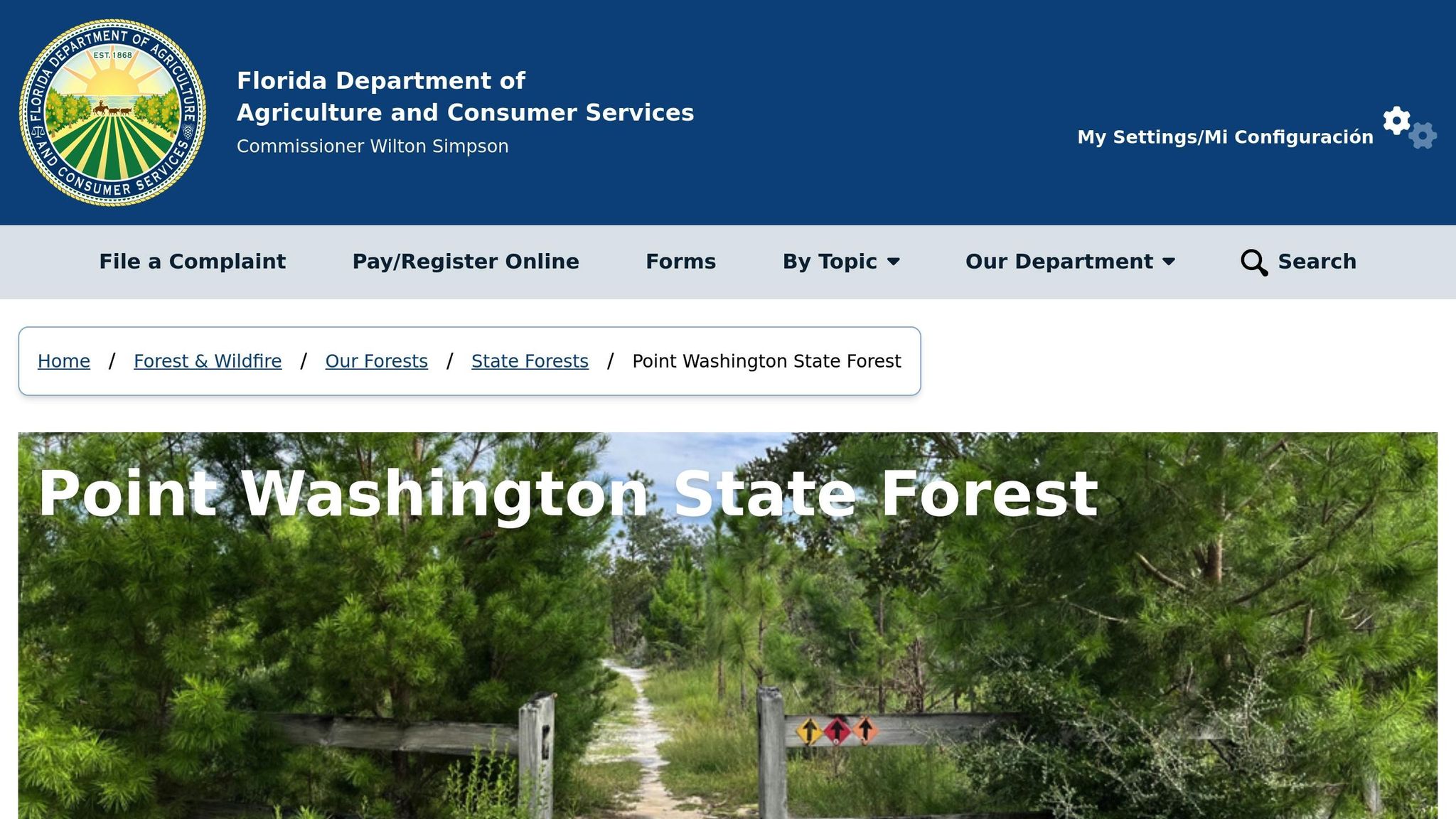
Spanning 15,000 acres, Point Washington State Forest offers a birdwatching experience unlike the coastal parks along 30A. With its inland setting and diverse habitats, it’s a standout destination for nature enthusiasts. As part of the Great Florida Birding Trail, it’s a go-to spot for both casual birders and seasoned ornithologists.
Habitat Diversity
Point Washington’s landscape is a patchwork of different habitats, each attracting its own variety of birds. The longleaf pine flatwoods provide vital nesting areas for woodpeckers and other pine-loving species. Open sandhills serve as feeding grounds for ground-dwelling birds, while wet prairies come alive with water-associated birds during the rainy season. The cypress swamps, with their serene wetlands, are perfect for wading birds, and the scrubby areas offer dense cover for migrating warblers. This mix of environments creates an ideal setting for a wide range of bird species.
Bird Species Variety
Positioned between two major migratory flyways, the forest is teeming with both resident and migratory birds. Red-headed woodpeckers are a common sight in the pine flatwoods, while prothonotary warblers bring bright color to the cypress swamps. Eastern bluebirds are often seen along the forest edges, and pine warblers fill the air with their melodic songs year-round. Raptors like ospreys and bald eagles frequently soar above the wetlands, adding to the excitement.
For those on the lookout for rare finds, Bachman’s sparrows or Swallow-tailed kites can be a special treat. During migration seasons, the forest bursts with activity as flocks of warblers and buntings - such as Indigo and Painted Buntings - pass through. Hawks and owls also make their presence known, drawing attention from raptor enthusiasts.
Accessibility
Getting to Point Washington State Forest is simple, with multiple trailheads located off County Road 395 and Highway 98. Parking is free, and the area is open year-round. The well-marked hiking and biking trails are mostly flat, making them accessible for all skill levels. However, facilities like restrooms and water stations are limited, so it’s wise to plan ahead.
Best Visiting Times
For the best birdwatching experience, head out early in the morning when the birds are most active. Spring and fall migration seasons bring the greatest variety of species, with fall offering particularly vibrant sightings as cold fronts bring waves of southbound migrants. Winter and summer are also rewarding for spotting resident birds, though summer visitors should come prepared with insect repellent.
To stay updated on trail conditions or local birding events, check out sowal.co, a digital guide for the South Walton and 30A area. Be sure to stick to marked trails and respect all posted guidelines to help preserve the sensitive habitats of this incredible forest.
7. Inlet Beach & Alys Beach Nature Trail
Wrapping up our journey through 30A's incredible birding spots, this stop combines the peaceful vibes of Inlet Beach with the lush greenery of the Alys Beach Nature Trail. Together, they offer a mix of serene coastal beauty and woodland charm, showcasing the diverse birdlife that makes this region a birdwatcher’s paradise.
Habitat Diversity
Inlet Beach and the Alys Beach Nature Trail bring together a fascinating mix of habitats. Here, you’ll find coastal dunes, sandy beaches, scrubland, and forested areas all in one place. The beach is a haven for shorebirds, teeming with insects and small crustaceans that serve as a buffet for hungry birds. Meanwhile, the nature trail winds through dense woodland, providing shelter and nesting spots for forest-dwelling species. This blend of environments highlights why 30A is such a magnet for bird enthusiasts.
Bird Species Variety
Inlet Beach is a standout spot for spotting the Semipalmated Plover, which thrives in the quiet, food-rich shoreline. Over at the Alys Beach Nature Trail, you'll be treated to sightings of Prothonotary Warblers lighting up the woods with their striking yellow plumage. Keep an eye out for Red-headed Woodpeckers darting among the trees and Ospreys soaring above the nearby waters.
As the sun sets, the trail becomes a prime location to hear or even spot Great Horned Owls. Their haunting hoots echo through the forest, creating unforgettable moments for those patient enough to wait for twilight. And thanks to the area's location along major migration routes, spring and fall bring an influx of migratory birds, adding even more variety to the mix.
Accessibility
Both spots are designed with ease of access in mind, making them great for birdwatchers of all skill levels. Inlet Beach offers public access with parking, making it simple to enjoy shorebird watching. The Alys Beach Nature Trail features a well-maintained, mostly flat path, suitable for most visitors. While sandy sections along the beach might be tricky for wheelchairs or strollers, the majority of both areas are accessible to most.
Best Visiting Times
Fall is the sweet spot for birdwatching here, as migratory birds follow the cooler weather through the region. Spring is another excellent time, with the arrival of birds heading north. For the best experience, plan your visit during the early morning or late afternoon, when birds are most active and lighting is perfect for photography. If you’re hoping to spot an owl, head to the trail at twilight for your best chance.
For those who prefer a guided experience, Coldwater Excursions Nature Tours offers tailored eco tours in the South Walton and 30A area, including birdwatching trips to these spots. And for up-to-date trail conditions or birding events, check out sowal.co to help plan your adventure along 30A.
Location Comparison Chart
Here's a quick look at 30A's best birdwatching spots. This table breaks down essential details, from habitat types to entry fees, so you can pick the perfect spot for your next outing.
| Location | Habitat Type | Signature Bird Species | Accessibility | Best Visiting Times | Entry Fee |
|---|---|---|---|---|---|
| Grayton Beach State Park | Coastal dunes, pine flatwoods, brackish lake | Snowy Plover, Bonaparte's Gull, Bald Eagle, 15+ wood-warblers | Trails, parking, loaner optics available | Fall, spring, winter; early morning | $4–$6 per vehicle |
| Topsail Hill Preserve State Park | Freshwater wetlands, coastal dune lakes, pine forests | Brown Pelican, Osprey, wading birds, songbirds | Boardwalks, ADA-compliant paths | Fall, spring; early morning | $4–$6 per vehicle |
| Eden Gardens State Park | Historic gardens, oak hammocks | Songbirds, woodpeckers, owls | Fully ADA-compliant paved paths | Spring, fall; early morning | $4–$6 per vehicle |
| Deer Lake State Park | Coastal dune lake, scrub habitat | Prothonotary Warblers, Osprey, Great Horned Owls | Boardwalks and trails | Fall, spring; early morning and dusk | $4–$6 per vehicle |
| Camp Helen State Park | Coastal dune lake, marsh, forest | Brown Pelican, herons, wading birds | Marked trails, parking | Fall, spring; early morning | $4–$6 per vehicle |
| Point Washington State Forest | Pine flatwoods, wetlands | Buntings, forest songbirds, woodpeckers, raptors | Unpaved trails | Fall, spring; early morning | Free |
| Inlet Beach & Alys Beach Nature Trail | Quiet beach, maritime forest, scrubland | Semipalmated Plover, Great Horned Owl | Well-maintained trail, beach access | Fall; early morning, late afternoon, dusk | Free |
Each location offers a unique mix of habitats, bird species, and amenities, catering to a variety of birdwatching interests. The diversity of ecosystems along 30A - ranging from coastal dunes to wetlands - creates an incredible range of opportunities for bird enthusiasts.
Over 200 bird species pass through 30A each year, with fall migration being especially active as cold fronts push birds through the area. State parks provide conveniences like restrooms, marked trails, and ranger assistance, while free sites offer a more rugged, natural experience.
The range of habitats directly influences the bird variety. For example, Grayton Beach State Park combines dunes, lakes, and forests, attracting both shorebirds and woodland species. Meanwhile, specialized areas like the Inlet Beach & Alys Beach Nature Trail focus on specific species, such as the Semipalmated Plover, which thrives along its calm, nutrient-rich shoreline.
Fall is the ideal season for birdwatching, followed closely by spring. Winter offers rare sightings, like Bonaparte's Gulls at Grayton Beach. Early mornings, typically from 6:00 AM to 9:00 AM, are the most active times, but dusk visits to forested spots like Deer Lake or Inlet Beach are great for spotting owls.
State parks generally open from 8:00 AM to sunset, with entry fees ranging from $4 to $6 per vehicle. Free sites may lack amenities but provide a raw, immersive experience. Summer mornings are best for beating the heat, and trails can be impacted by rain, so plan accordingly.
Conclusion
These seven birdwatching spots along 30A bring together a stunning variety of habitats and a passionate birding community. With over 200 bird species calling this area home throughout the year, it's a haven for both seasoned birders and curious newcomers. From the celebrated Grayton Beach State Park to hidden gems like Point Washington State Forest - where red-headed woodpeckers often make an appearance - each location offers something special.
Situated between two migratory flyways, 30A provides a unique opportunity to witness a mix of rare and seasonal birds. Picture yourself spotting prothonotary warblers in the wetlands of Deer Lake or catching a glimpse of great horned owls at dusk along the Alys Beach Nature Trail. These moments connect you to the natural rhythms of this remarkable region.
Thanks to its diverse landscapes - coastal dunes, brackish lakes, pine flatwoods, and maritime forests - every visit feels like a fresh adventure. Grayton Beach State Park alone hosts up to 15 species of wood-warblers during migration, a testament to the area's rich biodiversity.
As you explore, remember that your presence plays a role in protecting these delicate ecosystems. Stick to designated trails, minimize noise near nesting areas, and always pack out your trash. Simple actions like these help ensure these natural spaces remain vibrant for future generations.
"Our content is curated to help you experience South Walton like a local - with heart, curiosity, and an eye for the good life." - SoWal.co
For an even richer experience, plan your visit during fall or spring migrations and consider joining a guided tour for expert insights. Whether you're a local or just passing through, these seven birding spots promise unforgettable encounters that showcase why 30A is a top destination for birdwatching in the Southeast. Every sighting adds a deeper appreciation for the natural beauty that defines this area.
For the latest trail updates and birding events, check out sowal.co.
FAQs
What are the best times of year for birdwatching along 30A, and why?
The prime seasons for birdwatching along 30A are spring (March to May) and fall (September to November). These months align with migration periods, providing an opportunity to spot a diverse range of bird species passing through the region.
In spring, you’ll encounter colorful songbirds, while fall showcases shorebirds and raptors heading south. The comfortable weather during these times makes it even more pleasant to explore 30A's coastal dunes, state parks, and trails for a rewarding birdwatching experience.
Are the birdwatching spots along 30A accessible for visitors with mobility challenges?
Many birdwatching spots along 30A, like state parks and trails, cater to different accessibility needs. Some areas are equipped with paved paths and boardwalks, making them suitable for wheelchairs and strollers. However, other locations may have sandy or uneven trails that could be harder to navigate.
If accessibility is a priority, it's smart to look up specific spots ahead of time or reach out to local visitor centers for details on trail conditions and available amenities. Some parks even offer accessible viewing areas, ensuring everyone can enjoy the experience.
What bird species can I see at the coastal dune lakes along 30A?
The coastal dune lakes along 30A are a haven for bird enthusiasts, offering a chance to see an array of incredible species. Near the water, you might catch sight of great blue herons, snowy egrets, or even ospreys as they hunt and glide gracefully. These habitats also draw migratory birds like the striking roseate spoonbills and the sleek black skimmers, adding to the excitement for birdwatchers. Overhead, you might spot red-shouldered hawks patrolling the skies, while vibrant painted buntings can often be found flitting through the vegetation nearby. Make sure to bring your binoculars for the best experience!
